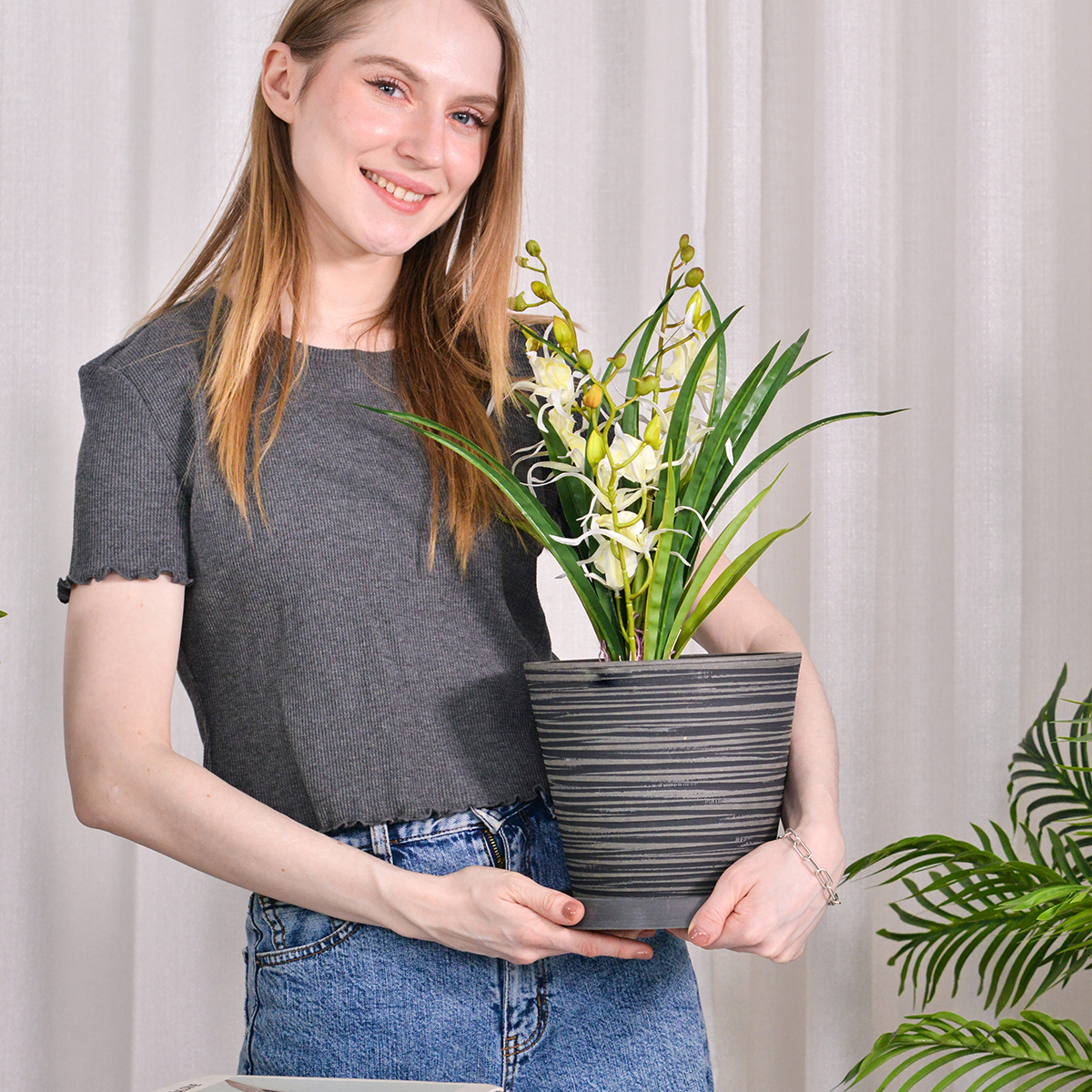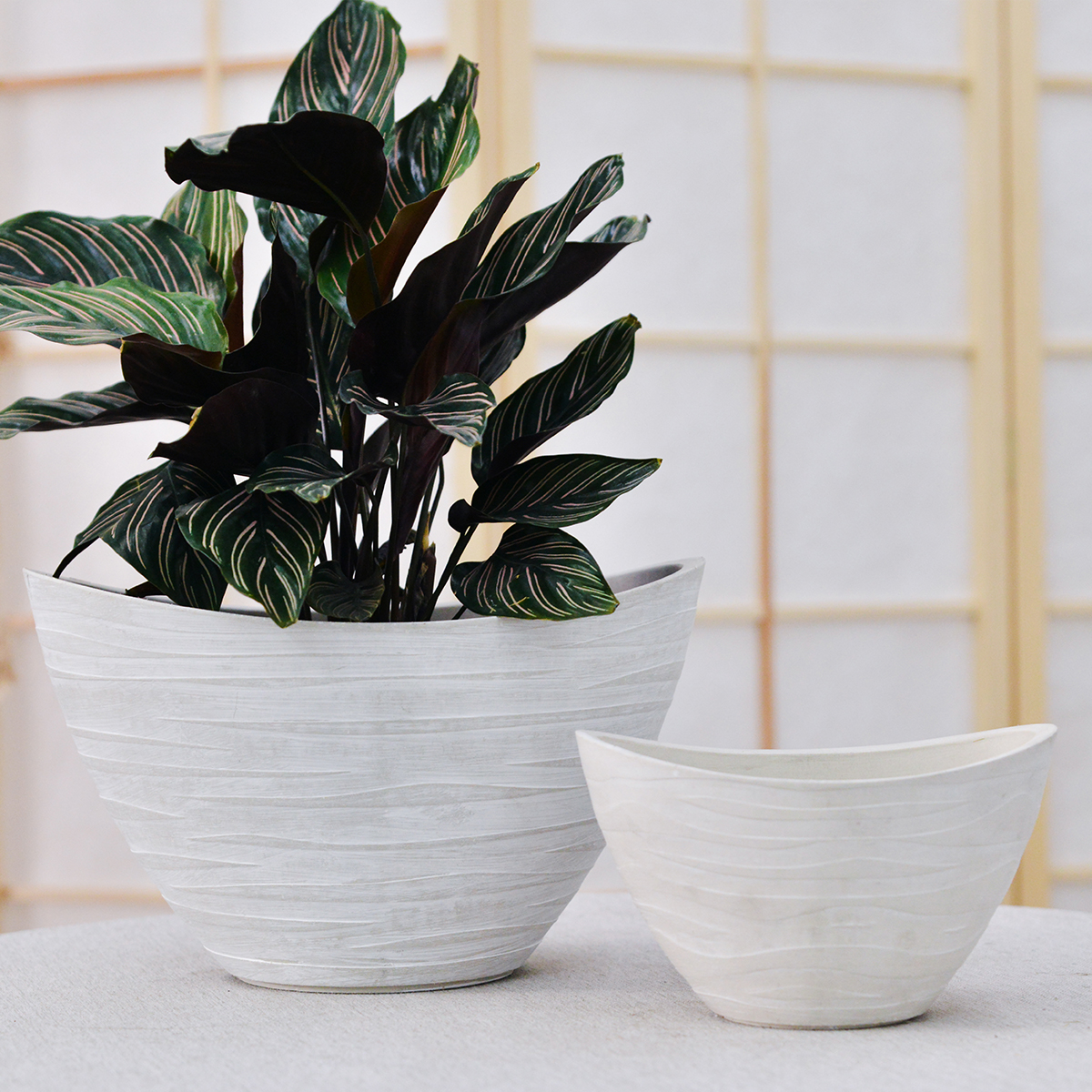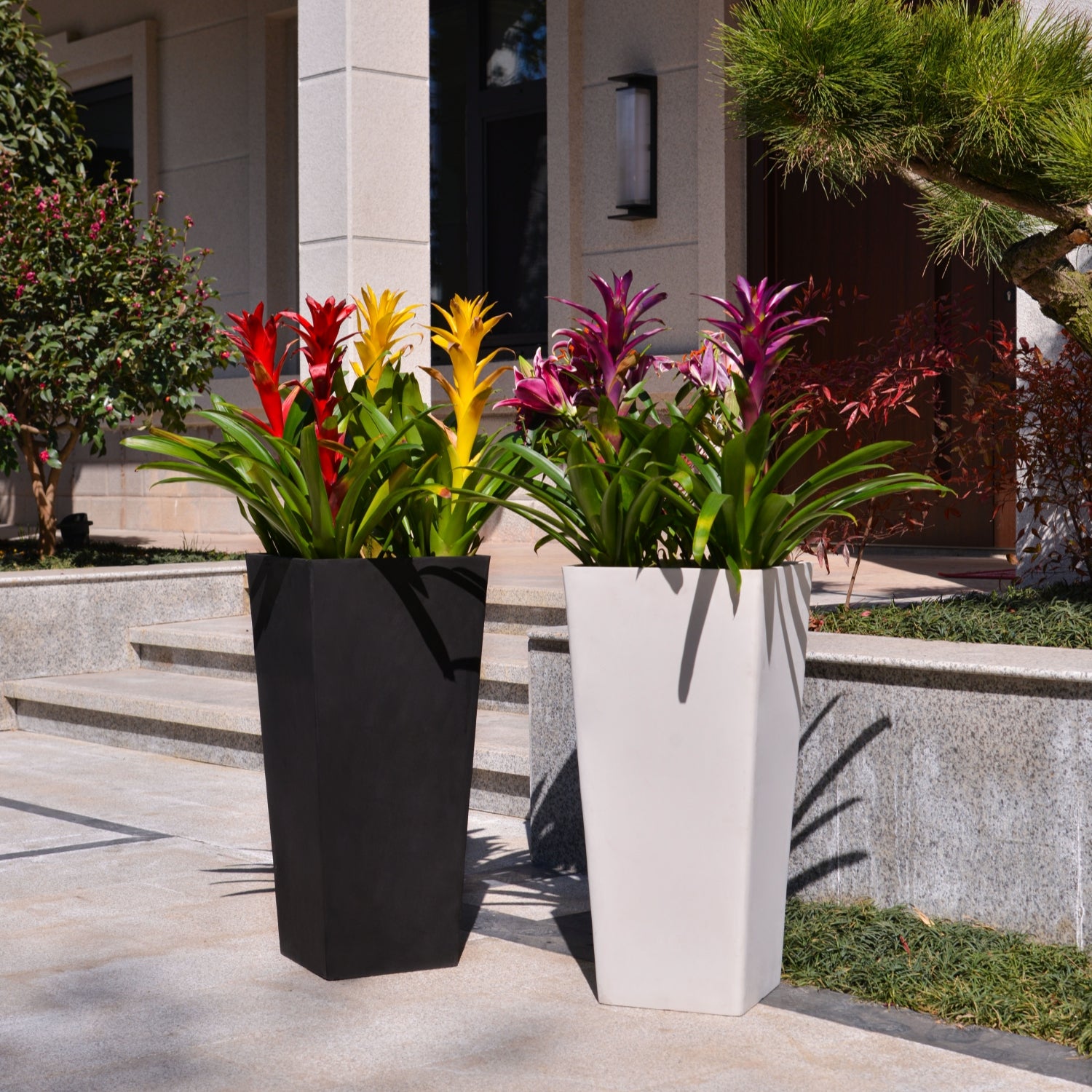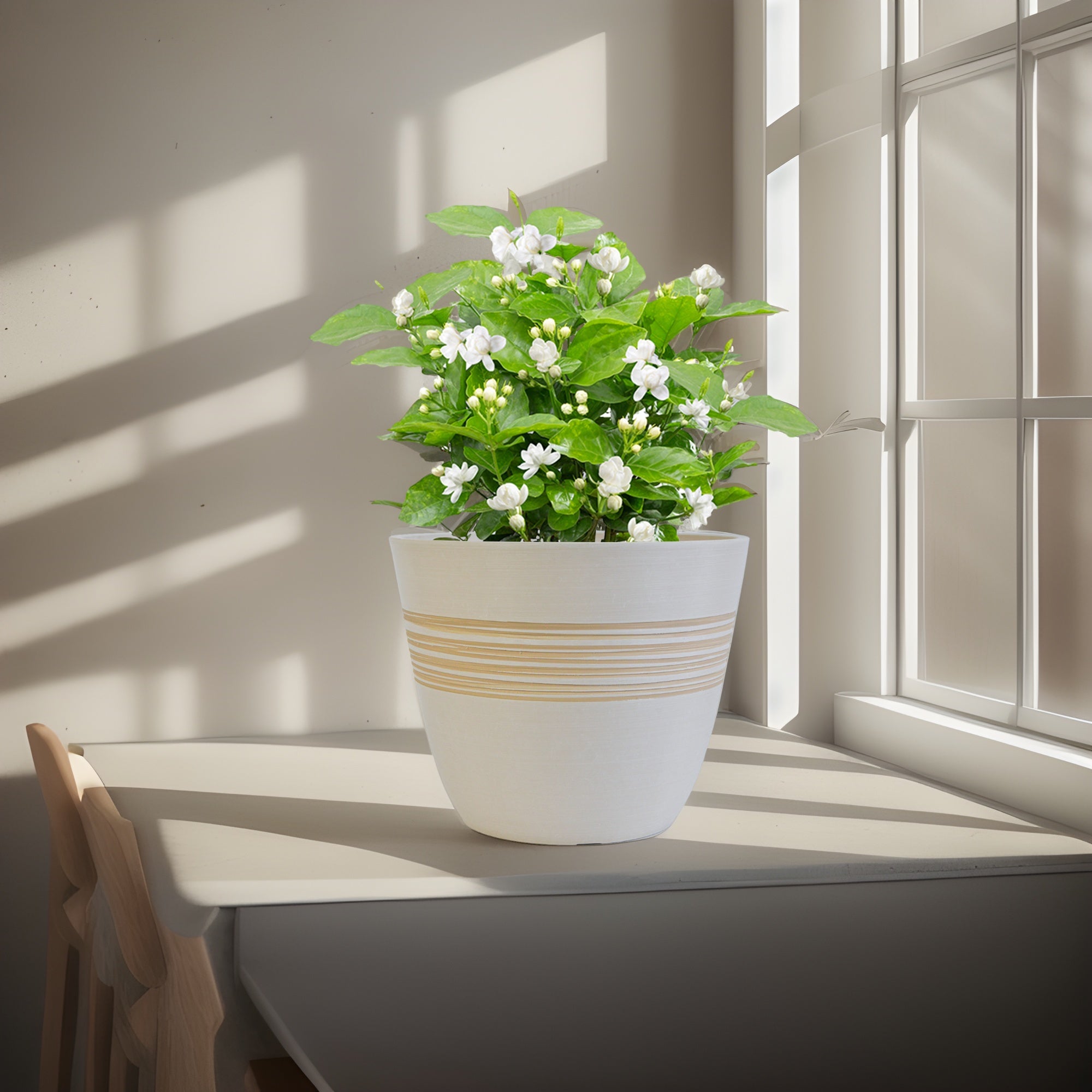Staghorn Fern Indoors: The Ultimate Guide to Growing Platycerium Bifurcatum at Home
Looking to add a dramatic, sculptural, and truly unique plant to your indoor jungle? Staghorn Fern, scientifically known as Platycerium bifurcatum, is an epiphytic fern prized for its distinctive, antler-like fronds and bold presence. These striking and relatively easy-to-grow ferns, native to Australia, Southeast Asia, and parts of Africa and South America, are perfect for adding a touch of wild elegance and living art to your indoor spaces. This comprehensive guide will provide you with everything you need to know to grow Platycerium bifurcatum indoors, from understanding its epiphytic nature to mastering essential care techniques for a thriving and magnificent Staghorn Fern in your home.
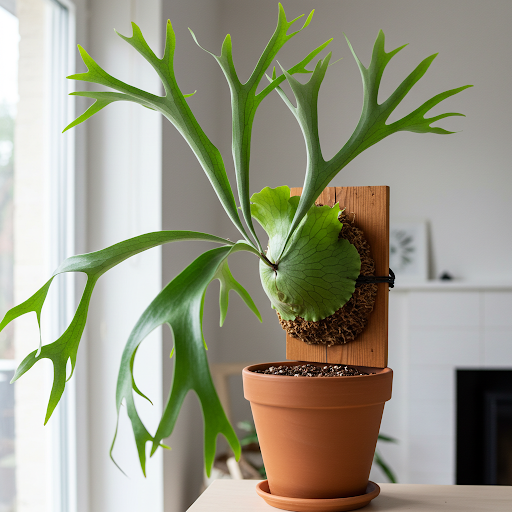
Staghorn Fern
What is Staghorn Fern (Platycerium bifurcatum)?
Platycerium bifurcatum, commonly known as Staghorn Fern, Elkhorn Fern, or Common Staghorn Fern, is one of the most popular and widely cultivated species within the Platycerium genus. Staghorn ferns are epiphytes, meaning they naturally grow attached to trees in their native rainforest habitats, rather than in soil. Platycerium bifurcatum is celebrated for its two types of fronds: * Basal Fronds (Shield Fronds): These are sterile, shield-like fronds that are rounded, brown, and clasp the mounting surface. They serve to anchor the fern and collect water and nutrients. They will naturally turn brown and papery with age – do not remove these brown basal fronds, as they are part of the plant’s natural growth and protection. * Foliar Fronds (Fertile Fronds): These are the dramatic, forked, and pendulous fronds that resemble the antlers of a stag or elk, giving the fern its common name. They are green and bear spores on their undersides in mature plants.
Staghorn ferns are known for their architectural beauty, air-purifying qualities, and relatively low-maintenance nature once their epiphytic needs are understood, making them a truly captivating and rewarding houseplant.
Can Staghorn Fern (Platycerium bifurcatum) Thrive Indoors?
Yes, Staghorn Fern (Platycerium bifurcatum) thrives exceptionally well indoors and is a popular choice for home cultivation. Mimicking their natural epiphytic habitat is key to their indoor success. While they may seem unusual compared to typical potted plants, understanding their unique needs for mounting, watering, and light will allow you to easily grow these magnificent ferns indoors and enjoy their dramatic beauty for years to come.
Ideal Indoor Growing Conditions for Staghorn Fern (Platycerium bifurcatum):
Varieties of Staghorn Fern (Platycerium bifurcatum): While Platycerium bifurcatum is the most common species, there are some variations and cultivars, though less pronounced than in some other plant genera. Variations may occur in frond shape, size, and overall growth habit. Look for healthy plants with vibrant green fertile fronds and intact basal fronds when selecting your Staghorn Fern.
Light: Staghorn Fern prefers bright, indirect light. In their natural rainforest habitat, they grow under the canopy of trees, receiving filtered sunlight. Indoors, they thrive in locations that receive bright, indirect light for most of the day. East-facing windows are often ideal, providing gentle morning sun. North or west-facing windows can also work if the light is bright but diffused. Avoid direct, intense afternoon sun, which can scorch the fertile fronds, causing them to turn yellow or brown. Insufficient light can lead to weak growth and less dramatic frond development.
Mounting vs. Potting (Pots): Staghorn ferns are epiphytes and are ideally grown mounted to mimic their natural growth habit. Mounting involves attaching the fern to a backing material such as a wooden board, cork bark, tree fern plaque, or wire basket. This allows for excellent air circulation around the roots and mimics their epiphytic needs. Potting in traditional pots is generally not recommended for long-term growth, as it can lead to root rot due to poor drainage and aeration. If you must pot a Staghorn Fern temporarily, use a very well-draining mix and a pot with excellent drainage.
Watering: Staghorn Ferns require consistent moisture, but good drainage and aeration are equally crucial. Water thoroughly when the mounting medium or potting mix is just beginning to dry out. The frequency will vary depending on humidity, temperature, air circulation, and the mounting material. The best watering method for mounted Staghorn Ferns is to soak the entire mount in a basin or sink of room temperature water for 10-20 minutes, allowing the mounting material to absorb moisture. Allow excess water to drain completely after soaking. For potted Staghorn Ferns (less ideal), water sparingly and allow the top inch of soil to dry out slightly between waterings. Never allow the Staghorn Fern to sit in standing water or become waterlogged, as this will lead to root rot. Reduce watering slightly in winter when growth slows down. Misting the fertile fronds occasionally can be beneficial, especially in dry indoor air.
Temperature: Average room temperatures between 60°F to 80°F (15°C to 27°C) are ideal. Staghorn Ferns are comfortable in typical household temperatures. Avoid exposing them to temperatures below 50°F (10°C) or sudden temperature fluctuations and cold drafts. They prefer moderate warmth and consistent temperatures.
Humidity: Staghorn Ferns thrive in moderate to high humidity, ideally between 50% to 70% or higher. High humidity is beneficial for healthy frond development and overall growth. Increase humidity by:
- Misting Regularly: Mist the fertile fronds and basal fronds (especially the aerial roots emerging from the basal fronds) frequently with room temperature water, especially in drier indoor environments.
- Pebble Trays: Place the mount or pot on a tray filled with pebbles and water (water level below the base).
- Humidifier: Use a room humidifier, especially during dry seasons or winter heating.
- Grouping Plants: Grouping Staghorn Ferns with other humidity-loving plants can create a more humid microclimate.
- Bathroom (if suitable light): A well-lit bathroom can be a suitable location due to naturally higher humidity.
Mounting Medium (if mounting): When mounting Staghorn Ferns, use a well-draining and moisture-retentive medium to wrap around the roots and basal fronds before attaching to the mount. Suitable mounting mediums include:
- Sphagnum Moss: Excellent for moisture retention and providing a natural look.
- Coconut Coir: Good drainage and aeration, sustainable alternative to peat moss.
- Orchid Bark: Provides excellent drainage and aeration, can be mixed with sphagnum moss or coconut coir.
- Fern Fiber: Specifically designed for epiphytic ferns, excellent drainage and aeration.
Planting/Mounting Your Staghorn Fern (Platycerium bifurcatum) Indoors:
- Starting from Pups or Established Mounted/Potted Plants: The easiest way to start growing Staghorn Ferns indoors is to purchase established mounted plants or pups (offsets that grow from the base of the mother plant) from nurseries, garden centers, or online retailers specializing in epiphytic plants and ferns.
- Propagation from Pups (Offsets): Staghorn Ferns produce pups around the base of the basal fronds. Once pups are a decent size (several inches across) and have developed their own small roots, they can be carefully separated from the mother plant and mounted or potted individually.
- Mounting Process:
- Prepare the Mount: Select a wooden board, cork bark, tree fern plaque, or wire basket.
- Prepare the Mounting Medium: Soak sphagnum moss, coconut coir, orchid bark, or fern fiber in water until moistened.
- Wrap the Roots and Basal Fronds: Gently remove the Staghorn Fern from its pot (if potted) and carefully remove excess soil, being gentle with the roots. Wrap the roots and basal fronds with a generous amount of the moistened mounting medium, forming a ball or pad around the base of the plant.
- Attach to the Mount: Position the wrapped root ball against the chosen mount. Secure it firmly using fishing line, florist wire, or nylon stockings. Wrap the line or wire around the mount and through the mounting medium, ensuring the fern is held securely against the mount. Avoid damaging the fronds.
- Hang or Display: Hang the mounted Staghorn Fern in a suitable location with appropriate light and humidity.
- Planting Time: Staghorn Ferns can be mounted or repotted at any time of year indoors. Spring or early summer, at the start of the growing season, is generally recommended for optimal establishment and growth.
Choosing the Right Pots (if potting, not recommended) for Indoor Staghorn Fern (Platycerium bifurcatum):
- Potting is generally discouraged for long-term Staghorn Fern cultivation. Mounting is highly preferred. If potting is necessary temporarily:
- Suitable Pot Types (for potting only): If you must pot temporarily, select pots with exceptional drainage and aeration. Orchid pots, terracotta pots with extra drainage holes, or wire baskets lined with coconut coir can be used. Drainage is paramount to prevent root rot.
- Drainage (for potting only): Drainage is absolutely critical if potting Staghorn Ferns. Ensure your chosen pot has large drainage holes at the bottom.
- Pot Size (for potting only): Choose a pot that is only slightly larger than the root ball. Overpotting greatly increases the risk of root rot.
- Potting Mix (for potting only): Use a very well-draining mix such as orchid mix, aroid mix, or a mix of bark, perlite, and sphagnum moss.
Essential Care Tips for a Thriving Indoor Staghorn Fern (Platycerium bifurcatum):
- Watering Schedule: “Soak Mount When Medium is Slightly Dry”. For mounted ferns, soak the entire mount when the mounting medium is just beginning to dry out. For potted ferns (not recommended), water sparingly only when the top inch of soil is dry. Avoid overwatering and soggy conditions.
- Fertilizing: Light Feeding During Growing Season. Staghorn Ferns benefit from light fertilization during the growing season (spring and summer) to support their frond growth. Fertilize every 1-2 months during the growing season with a diluted balanced liquid fertilizer (quarter strength) or a fertilizer specifically formulated for epiphytic ferns or orchids. You can also use diluted fish emulsion or seaweed extract. Apply fertilizer solution during soaking. Avoid over-fertilizing. Reduce or stop fertilizing during the fall and winter dormant period.
- Light Management: Bright Indirect Light is Key. Provide bright, indirect light. Avoid direct sun.
- Humidity is Beneficial: Maintain moderate to high humidity for optimal frond health and growth. Misting, pebble trays, or humidifiers are beneficial, especially in dry indoor air.
- Basal Fronds (Shield Fronds): Do Not Remove Brown Basal Fronds. The basal fronds will naturally turn brown and papery with age. This is normal and provides protection and nutrient collection for the fern. Do not remove these brown basal fronds.
- Pruning (Minimal): Minimal pruning is typically needed. You can trim away any damaged or truly unsightly fertile fronds, but generally, Staghorn Ferns are best left to their natural form.
- Remounting/Repotting Schedule: Mounted Staghorn Ferns may need to be remounted every 2-3 years as they grow larger and the mounting medium decomposes. Potted Staghorn Ferns (not recommended) may need repotting every 1-2 years if potted. Remount or repot in spring or early summer.
- Pest and Disease Control: Staghorn Ferns are generally relatively pest-resistant. Scale insects and mealybugs can occasionally occur. Root rot is the most common disease issue, caused by overwatering and poor drainage, especially when potted. Ensure proper mounting or excellent drainage if potted, and avoid overwatering to prevent root rot. Treat any pest infestations promptly with insecticidal soap or horticultural oil.
Popular Staghorn Fern Forms (within Platycerium bifurcatum):
- Platycerium bifurcatum (Common Staghorn Fern) – The classic form.
- Variations may occur in frond shape, size, and overall plant size among different sources.
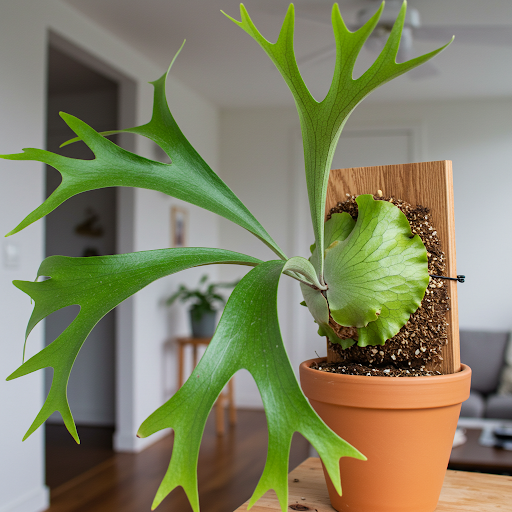
Staghorn Fern
In Summary:
Growing Staghorn Fern (Platycerium bifurcatum) indoors is a rewarding way to bring dramatic, sculptural beauty and a touch of the rainforest to your home. Their unique antler-like fronds and relatively easy care (when their epiphytic needs are met) make them captivating and long-lasting houseplants. By providing bright, indirect light, mounting them appropriately, watering by soaking when the medium is slightly dry, maintaining moderate to high humidity, and providing light fertilization, you can easily cultivate thriving and magnificent Staghorn Ferns indoors and enjoy their living art for many years to come.
For more detailed botanical information and to explore the diversity of the Platycerium genus, you can visit the Wikipedia page on Platycerium.
Important Note: Staghorn Fern (Platycerium) is considered non-toxic to humans and pets, making it a safe choice for households with children and animals. However, it’s always best to keep houseplants out of reach of pets and children who may be tempted to ingest them. The primary care challenge with Staghorn Ferns is understanding their epiphytic nature and providing appropriate mounting, watering, and humidity.
KC3-14A
By greenship|2024-08-16T06:26:30+00:00August 16, 2024|Categories: Hand-carving Series|
K2-11T
By greenship|2024-08-13T04:21:25+00:00August 13, 2024|Categories: Hand-carving Series|
20YB
By greenship|2024-08-16T05:37:57+00:00August 16, 2024|Categories: Hand-carving Series|
k2-21G
By greenship|2024-08-13T06:17:26+00:00August 13, 2024|Categories: Hand-carving Series|
GreenShip 27inch Tall Planters for Porch, Large Outdoor Planter Pots with Drainage Hole
By greenship-seo|2025-04-10T06:27:21+00:00April 7, 2025|Categories: Hand-carving Series|Tags: Decorative Flower Pots|
Planter for Indoor Outdoor Plants, Set of 2 Modern Decorative Plant Pots with Drainage Hole, Decorative Flower Pots
By greenship-seo|2025-04-10T07:46:01+00:00January 9, 2025|Categories: Hand-carving Series|Tags: Decorative Flower Pots, Self-Watering Pots|


